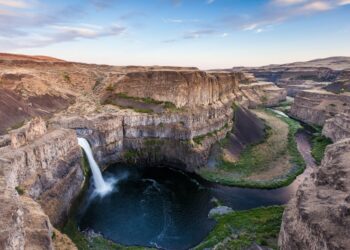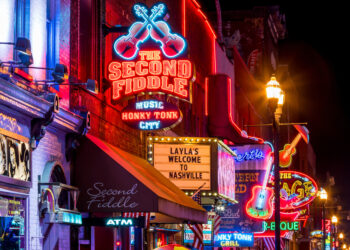Abu Dhabi is gorgeous. It’s a beautiful city, and that’s the thing that surprises most visitors. There’s a soaring skyline of shiny towers that reflect the shimmering sea. And the city is skirted by sea (it’s an island after all), a crystal clear, aquamarine colour. The beaches boast the most refined grains of white sand, and most are lined with date palm trees.
A seaside promenade, the Corniche, runs the length of the city, providing a great vantage point to enjoy the striking skyline. The best vistas are from a boat or the enormous flag pole at the Breakwater at sunset, a favourite local viewing spot.
Affiliate Disclaimer: Our blog posts may contain affiliate links. If you make a purchase through these links, we receive a modest commission at no extra cost to you. These commissions help us fund our team of travel writers, allowing us to continue providing you with the latest travel news, tips, and inspiration. Your support keeps this blog alive and thriving, and we appreciate it immensely. Thank you!
Abu Dhabi – The Corniche
My favourite part of the city, Abu Dhabi’s seaside promenade, deserves its own entry. This is where residents come out to play in the cooler months – and even in the sweltering warmer months. But it’s winter when the temperatures hover around the low 20s Celsius (high 60Fs), and the spring and fall months when they’re in the high 20Cs (high 70Fs / low 80Fs), that the Corniche sees most of the action.

Locals and ex-pats alike are out jogging, strolling, picnicking, snapping photos for their friends and family back home, rollerblading, skateboarding, cycling, and walking their dog along the Corniche. But, of course, come summer, when the temperatures are in the 40Cs (low 100Fs), you’ll only see locals here early morning or in the evening. So one of the first things you should do when you get to the city gets down there too! But slap on the sunscreen first and bring coins for water, cold drinks, and even ice creams, which you can buy from the vending machines on the route.
Abu Dhabi’s design
Abu Dhabi is a well-planned city with wide streets and traffic that flows freely. It’s easy to navigate and a breeze to get around. While Dubai is one of the world’s most popular spots, we can’t deny it is a sprawling mess of a metropolis with a chaotic old centre and suburbs that have sprouted up spontaneously, sneakily creeping into the surrounding desert. But Abu Dhabi was a city that was planned for growth from the start. The city has a grid-like urban design that was modelled on Manhattan, making it a place that’s easy to navigate and get to know. Sure, you’ll have a little traffic during peak hours and on weekend evenings when everyone is heading out. Still, then it actually has a real buzz about it.
Local tradition is alive in Abu Dhabi
The locals in Abu Dhabi are deeply devoted to their traditions – and they’re clinging on tight – and that’s what we love to see. They have a rich culture of local customs rooted in their Bedouin heritage and Islamic religion, like their tradition of Arab hospitality, and they’re doing their best to maintain them.
Take their national dress: unlike Dubai, where local kids increasingly wear Western clothes, in Abu Dhabi, the guys all wear crisp white dishdashas and checked gutras and agals, and the girls all don their elegant black abayas (cloaks) and shaylahs (headdress). When they walk by you on the streets and in the shopping malls, their heady perfumes and colognes also waft by. You’ll also see more ‘locals’, as we call the Emiratis, in the streets of Abu Dhabi than you do in Dubai. Head into the suburban neighbourhoods on a religious or national holiday, and you’ll see Emiratis singing songs and doing traditional dances.

Art & culture flourish in Abu Dhabi
Intellectual and serious, Abu Dhabi has always been Dubai’s more mature, arty, bookish sibling. The city has always been eager to preserve its culture and heritage – they even have a Nabati Poetry Academy! – but it’s also been keen to see modern and contemporary arts flourish too, long before Saadiyat Island’s sleek new museums were planned.
The capital has always benefited more than Dubai, from a lively international cultural exchange home to the UAE’s foreign embassies. It’s not unusual to see ambassadors and their spouses hobnobbing with Sheikhs over fruit juice and hors d’oeuvres in the foyer of Emirates Palace hotel or the Cultural Foundation as they wait for performances by the London Symphony Orchestra or the Bolshoi Ballet to begin.
The Cultural Foundation has always played host to the Arabian Peninsula’s most significant annual book fair and was responsible for starting the grassroots Emirates Film Competition, the country’s first local film festival, long before Dubai began its celebrity-driven International Film Festival. Coming up in April? The first WOMAD festival!
The Cultural Foundation
The Cultural Foundation has been Abu Dhabi’s artistic, intellectual and cultural centre for over three decades. An imposing building in the centre of the city, surrounded by shady parkland, it’s home to the national library and archives, an exhibition space, art workshops, and an enormous auditorium that has long hosted a vibrant nightly programme of classical music, theatre, ballet, traditional dance and song, and poetry performances.
Have a wander around and peek into the glass cabinets displaying Islamic art, calligraphy, traditional musical instruments, and fascinating old black and white photographs of the pre-oil capital. The Abu Dhabi depicted in the old images will astound – it was a sleepy village of barasti (palm frond) huts just fifty years ago. Upstairs is the cosy Delma Café, where you’ll be enjoying coffee in the company of Emirati poets, Jordanian theatre directors, Iraqi composers, and Indian filmmakers, who make up the Cultural Foundation’s multicultural staff.
Abu Dhabi’s Heritage Village
Overlooking the azure sea and the striking city skyline, the delightful Heritage Village (offers an insight into life before discovering oil. While you can wander about and browse replicas of a barasti (palm frond) house, small souq and traditional mosque, ride a camel in a Bedouin encampment, and watch craftsmen at work beating brass trays, weaving on traditional looms, and blowing glass, the highlight is its intimate but engaging fort museum. Inside are fascinating old black and white photos. Exhibits of old Bedouin costumes and jewellery, khanjars (daggers), bronze coffee pots, cooking utensils, and old baskets – the very things the women at the Cultural Foundation’s Heritage Corner (see below) and the craftsmen at the Heritage Village make to this day.
Qasr al Husn
In the lush grounds of the Cultural Foundation, the palm-filled courtyard gardens of the graceful white fort Qasr al Husn is a lovely place to stroll early in the morning or late afternoon. Enter via the impressive entrance decorated with pretty Portuguese tiles – if the majestic wooden doors aren’t open, climb through the small door spiked with iron nails.

The former palace residence of the ruling Al Nahayan family governed Abu Dhabi from the 18th century until 1966. The fort is the city’s oldest building, constructed in 1761. The fort is a maze of rooms decorated with painted reliefs of peacocks, flowers and Islamic calligraphy and connected by long corridors with mashrabiya screens and carved doors. Until recently, the interior is renovated to turn it into a museum home to the national archives. It might still be possible to look inside if you ask at the Cultural Foundation. If not, simply enjoy the fort’s elegance and the leafy gardens.
Heritage Corner
Heritage Corner, also known as Delma Corner (outside Delma Café), is part of the Abu Dhabi Cultural Foundation. And while it’s small, I think it’s rather unique. The Corner has wonderful local crafts for sale, featuring a traditionally decorated Bedouin tent strewn with camel bags, cushions, and carpets. The young Emirati hosts will pour you a tiny cup of the local cardamom-spiced coffee from an engraved brass coffee pot – it’s polite to accept three cups and tilt the cup gently from side to side when you’re sated – and you can watch the local Emirati ladies, their faces covered in the delicate gold or black burqa (masks that were originally worn to protect the skin from the sun) demonstrate traditional crafts.

You’ll see talli, a form of embroidery for making the gold and silver ribbons that embellish kandorahs (the loose dresses worn at home), and saddu, a textile-weaving technique to produce the bold striped carpets and camel bags. The women also weave palm fronds to create beautiful, brightly coloured baskets, and each of those has a different name too:
- Al jefeer is used to carry dates.
- The pyramid-shaped al makabba protects food from flies.
- Al goffa is essentially a traditional handbag.
And that’s about as sophisticated as tourism attractions get in Abu Dhabi. And that’s what we love about it!











